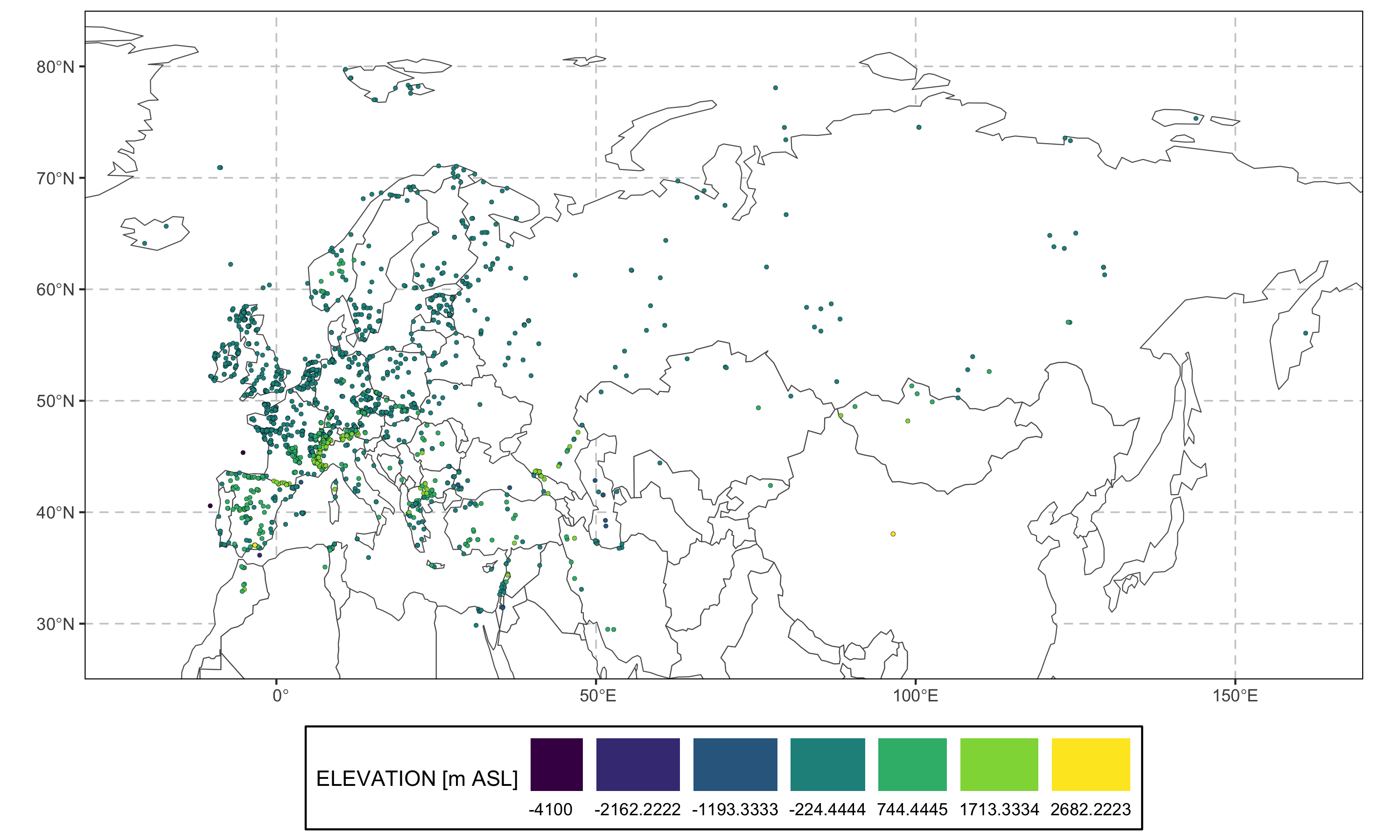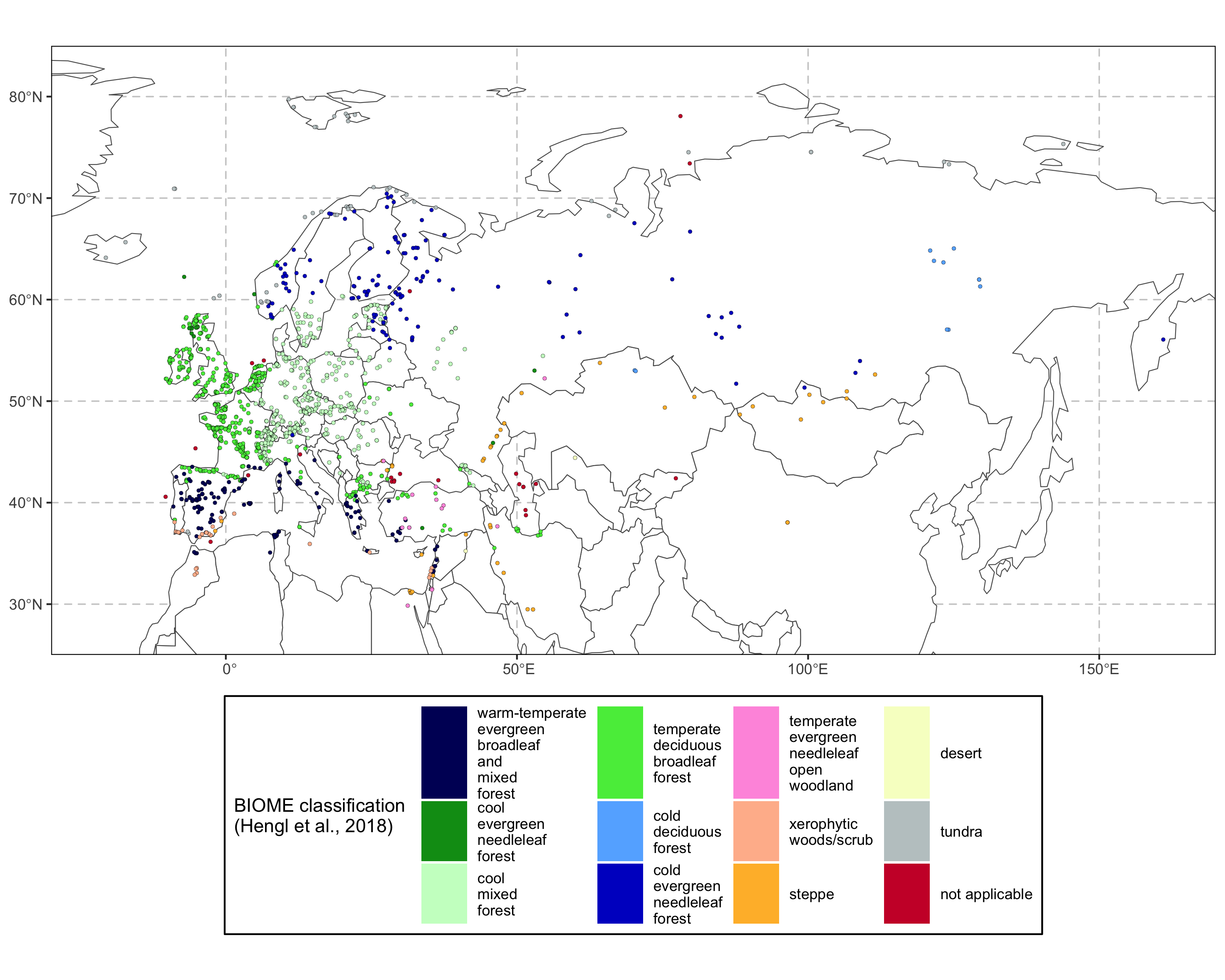The goal of special.epd is to provide access to the
SPECIAL Research group’s version of the European Pollen Database
(EPD).
Installation
You can(not) install the released version of
special.epd from CRAN with:
install.packages("special.epd")And the development version from GitHub with:
# install.packages("remotes")
remotes::install_github("special-uor/special.epd", "dev")Example
Create a snapshot of entities
The function special.epd::snapshot takes few different
parameters and based on the first one, x, it returns a
variety of snapshots.
This function returns a list with 5 components:
-
entity: data frame (tibbleobject) with the metadata associated to the entities. -
date_info: data frame (tibbleobject) with the dating information. This one can be linked to theentitytable using the column calledID_ENTITY. -
sample: data frame (tibbleobject) with the sampling information. This one can be linked to theentitytable using the column calledID_ENTITY. -
age_model: : data frame (tibbleobject) with the “new” age models (created with ageR). This one can be linked to thesampletable using the column calledID_SAMPLE. -
pollen_count: list of data frames (tibbleobjects) containing the pollen counts for 3 levels of “amalgamation”:cleanintermediateamalgamated
sampletable using the column calledID_SAMPLE.
⚠️ NOTE: the output is returned “invisibly”, so you should assign the output of the function to a variable.
output <- special.epd::snapshot(...)
output$entity
output$date_info
output$sample
output$pollen_count$clean
output$pollen_count$intermediate
output$pollen_count$intermediateUsing the entity_name
special.epd::snapshot("MBA3")
#> # A tibble: 1 × 8
#> ID_SITE ID_ENTITY site_name entity_name dates samples age_model
#> <int> <int> <chr> <chr> <int> <int> <int>
#> 1 1 1 Aalkistensee MBA3 7 57 57
#> # … with 1 more variable: pollen_counts <tibble[,3]>Using the site_name
special.epd::snapshot("Abant Golu", use_site_name = TRUE)
#> # A tibble: 1 × 8
#> ID_SITE ID_ENTITY site_name entity_name dates samples age_model
#> <int> <int> <chr> <chr> <int> <int> <int>
#> 1 4 4 Abant Golu ABANT 5 65 65
#> # … with 1 more variable: pollen_counts <tibble[,3]>Using the ID_ENTITY
special.epd::snapshot(2)
#> # A tibble: 1 × 8
#> ID_SITE ID_ENTITY site_name entity_name dates samples age_model
#> <int> <int> <chr> <chr> <int> <int> <int>
#> 1 2 2 Aammiq AMMIQ 4 96 96
#> # … with 1 more variable: pollen_counts <tibble[,3]>Using the ID_SITE
special.epd::snapshot(3, use_id_site = TRUE)
#> # A tibble: 1 × 8
#> ID_SITE ID_ENTITY site_name entity_name dates samples age_model
#> <int> <int> <chr> <chr> <int> <int> <int>
#> 1 3 3 Aansser peat bog ANS 4 64 64
#> # … with 1 more variable: pollen_counts <tibble[,3]>Extracting multiple records at once
special.epd::snapshot(1:10)
#> # A tibble: 10 × 8
#> ID_SITE ID_ENTITY site_name entity_name dates samples age_model
#> <int> <int> <chr> <chr> <int> <int> <int>
#> 1 1 1 Aalkistensee MBA3 7 57 57
#> 2 2 2 Aammiq AMMIQ 4 96 96
#> 3 3 3 Aansser peat bog ANS 4 64 64
#> 4 4 4 Abant Golu ABANT 5 65 65
#> 5 5 5 Abborrtjarnen ABBO 7 107 107
#> 6 6 6 Abernethy Forest AF1974 7 49 49
#> 7 7 7 Abiare ABIARE 1 34 0
#> 8 8 8 Above Cadubh ACH3 1 7 0
#> 9 9 9 Above Loch an Eang AFF5 4 10 10
#> 10 10 10 Achit-Nur ACHIT8 4 20 20
#> # … with 1 more variable: pollen_counts <tibble[,3]>Extracting all the records at once
This will run very slow, so if only few entities are required, it would be better to indicate which, based on the previous examples.
out <- special.epd::snapshot()Export data as individual CSV files
The function special.epd::write_csvs takes to
parameters:
-
.data: a list of classsnapshot, this one can be generated using the functionspecial.epd::snapshot(see previous section). -
prefix: a prefix name to be included in each individual files, this prefix can include a relative or absolute path to a directory in the local machine.
Without a path
`%>%` <- special.epd::`%>%`
special.epd::snapshot("MBA3") %>%
special.epd::write_csvs(prefix = "MBA3")
#> # A tibble: 1 × 8
#> ID_SITE ID_ENTITY site_name entity_name dates samples age_model
#> <int> <int> <chr> <chr> <int> <int> <int>
#> 1 1 1 Aalkistensee MBA3 7 57 57
#> # … with 1 more variable: pollen_counts <tibble[,3]>Including a path
`%>%` <- special.epd::`%>%`
special.epd::snapshot("MBA3") %>%
special.epd::write_csvs(prefix = "/special.uor/epd/MBA3")Spatial distribution of the entities
`%>%` <- special.epd::`%>%`
special.epd::entity %>%
smpds::plot_climate(var = "elevation", units = "m ASL",
ylim = c(25, 85),
xlim = c(-30, 170))
Extract Potential Natural Vegetation (PNV)
Using the package smpds [https://github.com/special-uor/smpds] we can extract the
PNV for each entity and create a plot:
`%>%` <- special.epd::`%>%`
special.epd_pnv <- special.epd::entity %>%
smpds::extract_biome()
# For a quicker execution
special.epd_pnv <- special.epd::entity %>%
smpds::parallel_extract_biome(cpus = 4)
# Plot the PNV
special.epd_pnv %>%
smpds::plot_biome(ylim = c(25, 85),
xlim = c(-30, 170))
Summary of the database
`%>%` <- special.epd::`%>%`
special_epd_summary <- special.epd::db_summary()
tibble::tibble(
`# Entities` = nrow(special_epd_summary),
`with Dates` = sum(special_epd_summary$has_DATES, na.rm = TRUE),
`with Age models (using IntCal20)` = sum(special_epd_summary$has_AM, na.rm = TRUE),
`with Pollen counts` = sum(special_epd_summary$has_COUNTS, na.rm = TRUE)
) %>%
knitr::kable()| # Entities | with Dates | with Age models (using IntCal20) | with Pollen counts |
|---|---|---|---|
| 1667 | 1667 | 1476 | 1667 |
